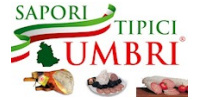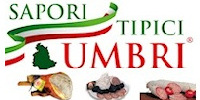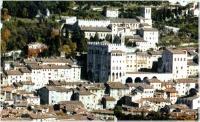 |
| Veduta di Gubbio |
Outside
Porta Romana stands the architectural complex of the
church of Sant’Agostino, started in 1251 but not finally consecrated until 1294. The brick facade was rebuilt in 1790. The single nave interior is divided into eight section arches, a common architectural formula in Gubbio, and contains frescoes by Ottaviano Nelli and his workshop in the pseudo-chapels between the spans and particularly on the triumphal archway (‘The Last Judgement’). The apse is decorated with 26 episodes of the ‘Life of St Augustine’, also painted by Nelli between 1422 and 1427. They are a reliable depiction of what life was like in Gubbio at the time.
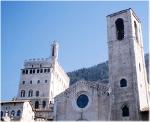 |
| Centro storico |
Coming back into town through Porta Romana, the
church of Santa Maria Nuova is in the
Sant’Andrea district of town. Built in the 12th century, the church’s *** doorway is placed off centre. The interior re-arrangements carried out in the 17th century thankfully spared the fine frescoes by Ottaviano Nelli and his workshop. The ‘Madonna of the Belvedere’ (1403 or 1413) is among the most noticeable and is one of the most important Gothic works in the whole of Umbria. The central of the three Baroque altars comes from the church of Sant’Agostino and is by Antonio and Giambattista Maffei. One of the two urns that previously contained the remains of St Ubaldo has been entirely painted by an artist known as the Maestro Espressionista di Santa Chiara. The church of
Sant’Andrea is not far off. Part of the Benedictine monastery of San Marziale, the church is 12th century. Its two naves are topped by vaulted ceilings, one barrelled and the other crossed. The apses have been built using scrap material from the remains of a Roman temple, over which they stand. Downhill into the
San Pietro area of town stands the
church of San Pietro, part of another 13th century Benedictine convent. A glance at the facade is sufficient to notice that the church has been built on a previously existing Romanesque basilica of the 11th century. The structure is composed of three naves, while the columns that have been used in the facade are even older than the previous building and probably date from the 6th century. In 1519 both church and convent were taken over by the Olivetani friars who redecorated the interior in Renaissance style, leaving only the polygonal Gothic apse untouched. The round window was walled up and two lateral windows were opened in the facade to make way for the imposing main organ. A secondary organ from the 18th century is in the apse. The main organ is Flemish, from 1598, while the case was designed by Antonio and Giambattista Maffei of Gubbio. The fifth chapel on the right contains an interesting ‘Adoration’ by Raffaellino del Colle (1510), as well as two frescoes painted at a time when he had already come into contact with Raphael and Vasari.
Back towards the town centre stands the
church of San Giovanni Battista, probably built on the site where the late 13th century cathedral of Gubbio once stood. The interior arches are a Cistercian variation of the standard ogival formula, with the arches themselves supported by coupled columns. The baptistery chapel is Gothic with a Renaissance layout and is later than the rest of the church. Inside, the font is in majolica surmounted by a hexagonal marble and wood Renaissance temple and an altar piece depicting ‘The Baptism of Jesus’ of the school of Perugino. Next to the first altar on the left hangs a 16th century canvas by Benedetto Nucci di Gubbio, depicting ‘St Lucy and St Barbara’.
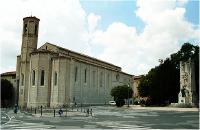 |
| Chiesa di San Francesco |
On the way to the largest square in Gubbio,
Piazza dei Quaranta Martiri (once Piazza del Mercato but named thus after the Germans killed forty people here during reprisals in 1944), runs the long building of the Ospedale della Misericordia (also known as Spedal Grande, 1326). The Loggia dei Tiratori di Lana, added in 1603 by the powerful wool weavers corporation and used by them to dry out their wares, runs along the entire length of the building. The hospital itself once belonged to the confraternity of the Disciplinati Bianchi, known also as Laici, who also owned the adjacent church of Santa Maria dei Laici. The facade is 18th century but the church itself is from the same period as the hospital. The interior is decorated with 24 canvases depicting ‘Episodes from the Life of Mary’, by Felice Damiani of Gubbio (second half of the 16th century). At the left hand altar is the last work by the Urbino artist Federico Barocci, ‘Annunciation’. The lower section was completed in 1612 by one of his pupils.
The southern side of this spacious square is occupied by the buildings of the convent and church of San Francesco. Construction was in part financed by the Spadalonga family, wool traders who gave hospitality to St Francis during his sojourn in Gubbio between 1206 and 1207. These funds were donated to the Franciscan community in 1214. Works began in 1256 and stopped by the end of the same century. The simple facade is decorated with a Romanesque doorway. Its upper section was never completed. The rose window was only installed in 1958 and comes from San Francesco in Foligno. On the left hand wall a twin portal has been walled up. It is surmounted by an extremely elaborate 14th century rose window. Parts of the single mullioned windows of the wall were also walled up when the interior of the church was renovated in 1724. The octagonal bell tower, from the 15th century, was added by building on top of one of the three original polygonal apses. The majestic interior is divided into three naves of high columns. Following works in the 18th century, the barrel vaults were added to the central nave. The lateral naves have 15th century cross-vaulting, although originally the entire ceiling was trussed. The left hand apse contains ‘Episodes from the Life of Mary’, by Ottaviano Nelli (1408-1413). Along with cycle of St Augustine, these works constitute Nelli’s greatest artistic achievement. The frescoes in the central nave are 12th century but have been re-painted and represent ‘Christ Enthroned’ along with St Peter, St Paul, St Francis and St Anthony of Padua. The right hand apse stands on the spot where the Spadalonga family allegedly gave St Francis his tunic. It is divided in two by a 15th century vault and contains two different cycles of frescoes, both painted by Guido Palmeruccio. The upper section features ‘Francis Renouncing His Father’s Worldly Possessions’ and ‘The Dream of Innocent III’. In the lower section there is ‘Christ the Redeemer Surrounded by the Four Evangelists’, along with depictions of various saints on the walls. An exit on the right hand side of the apse leads to the sacristy, built with the funds donated by the Spadalonga family, and from there to the 14th century Chiostro della Pace. The Sala del Capitolo was built at the same time as the church, although it was reduced in size during the 15th century. The trilobate doorway and the two two-mullioned windows were brought back to light in 1965.
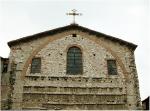 |
| Chiesa di San Domenico |
Along Via Cavour stands Palazzo Beni, built at the end of the 14th century once the family had returned from exile on account of its Ghibelline affiliations. The single facade in fact unites a series of houses that belonged to the Benis. The entrance is 17th century. The building is currently abandoned. Via Cavour eventually leads into Piazza Giordano Bruno, onto which faces the church of San Domenico.The church we see today, built around 1300, in fact stands on a previous church that had been dedicated to St Martin - hence the name of this area of the city. Various alterations were made during the 17th century: the incomplete facade was partly pushed back, while the choir was moved outwards and a transept was added. The entire interior was then vaulted. A series of lateral niches were also inserted. Recent works have brought to light some 14th century chapels that contain interesting frescoes by local 14th and 15th century artists (the first on the left and right). The choir, with its inlaid music stand by Mariotto di Paolo is particularly fine. It has been largely agreed upon nowadays, however, that this is the work of Giovanni da Verona. The second chapel on the left contains frescoes by Ottaviano (or Tommaso) Nelli, ‘St Vincenzo Ferrer’ and ‘St Peter Martyr’. In the fourth chapel to the left there is a ‘Madonna with Child and Angels Playing’ by Raffaellino del Colle (1546), while the fifth chapel contains Giovanni Baglione’s ‘St Mary Magdalene’ (first half of the 17th century) and an early 15th century terracotta ‘Pietà’. The seventh chapel on the left contains a locally crafted statue of ‘St Antonio Abate’, allegedly made by a certain Mastro Giorgio.
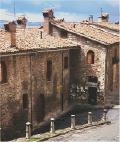 |
| Una stradina del centro |
After Via Vantaggi, Via Gabrielli runs along the large Palazzo Gabrielli. The building’s high tower is stands out clearly on the Gubbio cityscape. When this family rose to power, at the time when Gubbio was ruled by the Montefeltro family, they abolished the position of magistrate of the Capitano del Popolo and used the Palazzo del Capitano del Popolo as their own residence. Built on three floors at the end of the 13th century, the main floor of the palazzo is occupied by the Salone del Consiglio. The Gabriellis added the fireplace in the 15th century. An interesting basin with three taps is kept in the quarter that were once occupied by the guards. A large oval slab, known as il Pietrone, has been inserted into the street paving opposite the entrances to the palazzo. During the Good Friday procession from the church of Santa Croce della Foce just outside Porta Metauro, the coffin that contains the body of Christ is laid to rest here for a few moments, according to a tradition that has been continuing since the Middle Ages.





